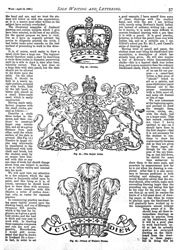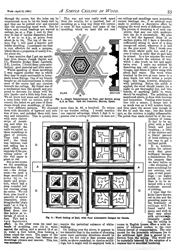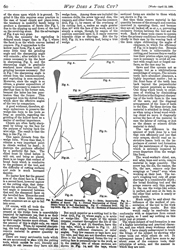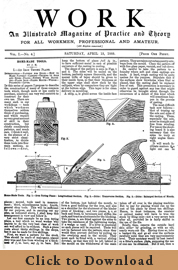Part of the thrill of
Work is the unceasing barrage of wacky projects. But let's face it, this is Tools for Working Wood. Chances are, you're not reading this because you have an unhealthy interest in
cloisonné apiary fixtures. Rococo skeps will have to wait for a later issue. Today, Issue No.4 is out, and plane-making is on the menu, so strap in.

Consultation with Joel has lead me to believe that articles such as this are responsible for high numbers of unattributable, unbranded antique planes of this pattern. It makes sense to me. The article insists that, while a milling machine might save you some time, you should be able to manage just fine with a set of files and a patient mind. I challenge anyone to read this and not be tempted to make a plane of your own.
"Lathes and Turning Appliances" gives a series of tests by which you can judge the quality potential purchases. The list is fairly exhaustive and seems to imply an awfully permissive lathe salesman or showroom. That said, when Ben and I bought the
LeBlond for the Gramercy shop, we came armed with a
DTI and a
checklist.
Hiram Price mentions inexpensive, steam-struck mouldings in his continuation of "A Simple Ceiling In Wood." I'm wondering if this is the same thing Joel described in his recent
blog.
The second installment of "Why Does A Tool Cut" devotes itself primarily to the correct method of sharpening woodworking tools. Hollow grinding of the bevel is described, and anyone familiar with this
technique will be immediately satisfied with the commentary. Anyone unfamiliar with hollow grinding ought to read carefully.
A chemical glossary for electro-plating, color schema for crystoleum painting, and various illustrative aspects of sign-writing are all included in Issue No. 4, but I'm sure at this point, Work-appreciators all over are quite through with my rambling.
Comment fields are below. If any particular aspect of this issue piques your interest, by all means please bring it to the attention our burgeoning legion.
–TIM
ARTICLES FOUND IN THIS ISSUE:
Home-Made Tools: An Iron Trying Pane • Lathes And Turning Appliances (Part 2)
A Simple Ceiling In Wood (Part 2) •Friendly Hints To Amateur Woodworkers
Sign Writing And Lettering (Part 3) • Crystoleum Painting (Part 2)
Notes For Electro-Platers • Why Does A Tool Cut (Part 2) • Our Guide To Good Things
Shop: A Corner For Those Who Want To Talk It
• Click to Download Vol.1 - No.4 •



Disclaimer: Articles in Work: The Illustrated Weekly Journal for Mechanics describe materials and methods that would not be considered safe or advisable today. We are not responsible for the content of these magazines, and cannot take any responsibility for anyone attempting projects or procedures described therein.
The first issue of Work was published on March 23rd, 1889. The goal of this project is to release digital copies of the individual issues starting on the same date in 2012, effectively republishing the materials 123 years to the day from their original release.
The original printing was on thin, inexpensive paper. There are many cases of uneven inking and bleed-through from the page behind. Our copies of Work come from bound library volumes of these issues and are subject to unfavorable trimming, missing covers, etc. Please bear with us if a margin is clipped too close, or a few words are unreadable. To minimize harm to these fragile volumes, we've undertaken the task of scanning the books ourselves. We would like to thank James Vasile and Karl Fogel for their help in supplying us with a book scanner and generally enabling this project to get off the ground.
The original content is out of copyright, however, our scans and processing are not. You are welcome to download, print, and pretty much do what you want with the scan for your own personal purposes. Feel free to post a link or a copy on your blog or website. All we ask is a link back to the original project and this blog. We are not giving permission for commercial downloads or reprinting at this time.
 Joel's Blog
Joel's Blog Built-It Blog
Built-It Blog Video Roundup
Video Roundup Classes & Events
Classes & Events Work Magazine
Work Magazine





















